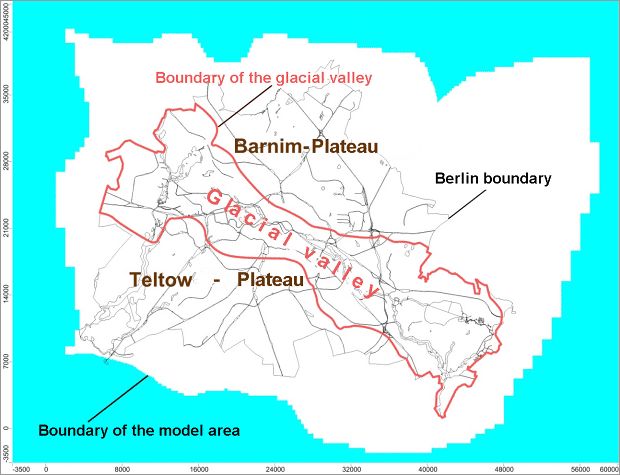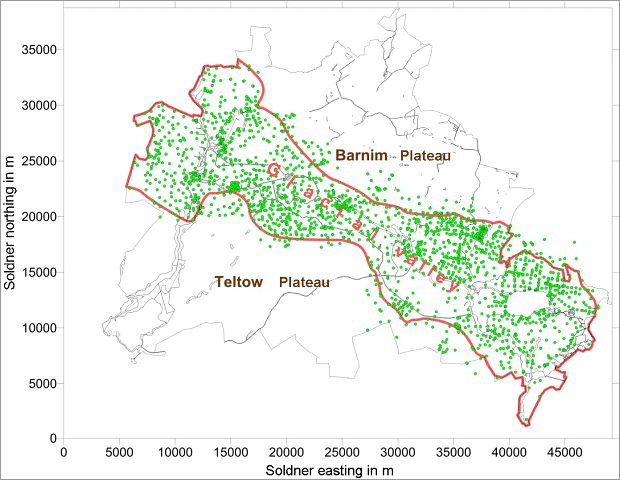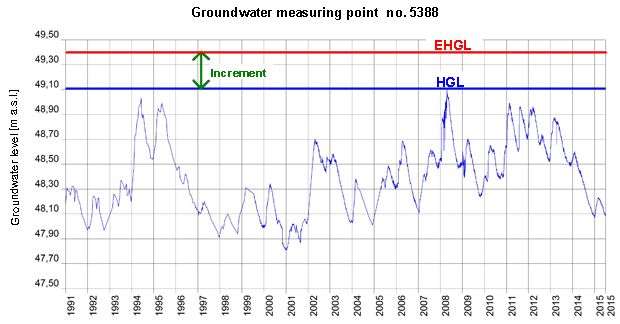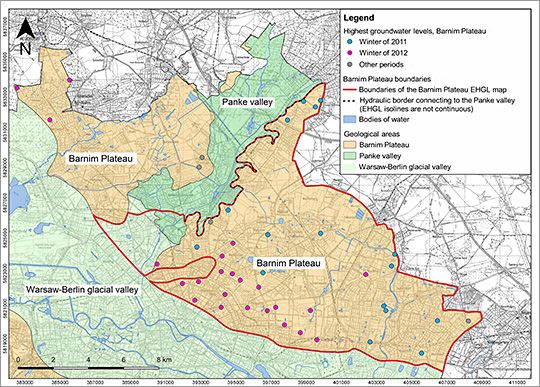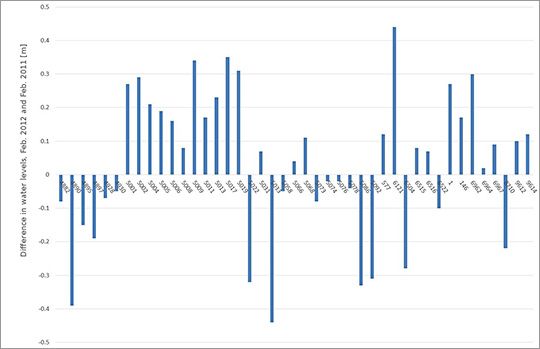In the course of developing the numerical groundwater flow model for the Barnim Plateau, it emerged that the required hydrogeological data is relatively poor in some areas. Furthermore, it became clear that the complexity of the hydrogeological conditions, which are highly intricate in some parts, could not always be mapped with sufficient accuracy. A very strict analysis of the calculated EHGL map revealed that one section of the EHGL model does not yet meet the particularly high quality requirements set out for an EHGL model.
Similar to the Panke valley, HGL measurements were therefore initially used to develop the EHGL map. Groundwater levels from the year 2000 were used for this purpose. This is possible, as anthropogenic influence has become rather insignificant as a factor, following the cessation of water pumping at the Buch waterworks and the levelling of sewage farms in the 1990s.
The EHGL map for the area of the Barnim Plateau southeast of the Panke valley does not only include the plateau as presented on the geological map of Berlin, but also a small adjacent area, where the Panke valley transitions to the glacial valley (see Fig. 2). The area of the Barnim Plateau west of the Panke valley, however, is not included in these maps. On the one hand, the main aquifer does not cover a large area here. On the other hand, further analyses of the hydrogeological situation would be necessary to be able to provide reliable information on the EHGL.
The following steps were taken to calculate the EHGL map in the area of the Barnim Plateau located south-east of the Panke valley:
1. Hydrograph analysis
A statistical analysis was carried out for the groundwater levels of 43 representative groundwater measuring points, which the main aquifer filters (GWL 2.1, GWL 2.2, GWL 2) according to the aquifer nomenclature of Limberg & Thierbach (2002). Only data from the year 2000 and later was included in this evaluation. Prior to the year 2000, artificial groundwater recharge in the area of former sewage farms and the groundwater lowering by the Buch waterworks may have had a hydraulic impact on groundwater levels.
Initially, the data sets were checked for data errors. Furthermore, it was a prerequisite for use that the measurement series not contain any considerable measurement gaps and cover at least 80 % of the observation period. The groundwater level measured on day 15 of each month was used for evaluation.
The aim of the evaluation was to determine the month with the highest groundwater levels in the observation period and to determine the maximum groundwater increase during the winter half of the year and caused by heavy precipitation events in the summer respectively.
On the Barnim Plateau, the highest groundwater levels were measured in the winter of 2012 (23 groundwater measuring points) and the winter of 2011 (16 groundwater measuring points). In the winter months of 2008, maximum values were recorded at 3 groundwater measuring points and at 1 measuring point in 2002. February 2012 was the month with the highest groundwater levels with 21 peak values. In the winter of 2011, the highest groundwater levels were also recorded in February with 13 peak values. Figure 7 reveals that the measuring points that recorded maximum values in the winter of 2012 (highlighted in pink) are located in the southern section of the Barnim Plateau and in the north-west (Frohnau/Hermsdorf), while the measuring points that recorded maximum values in the winter of 2011 (highlighted in blue) are mainly located in the north and the east.
Figure 8 illustrates the difference in water levels between the two peak levels of winter 2012 and 2011. The groundwater levels recorded at the northern and eastern groundwater measuring points (highlighted in blue in Figure 7) in the winter of 2012 read up to 0.44 m below the maximum water levels in 2011. The median is 0.10 m lower than that of the water levels of 2011. In the southern groundwater measuring points (highlighted in pink in Figure 7), the 2012 water levels were 0.17 m higher on average than the 2011 water levels.
The highest groundwater increases across all groundwater measuring points investigated on the Barnim Plateau within a month is 0.39 m and can be attributed to heavy precipitation events that occurred in June/July 2017. When investigating groundwater increases across several months, the winter months from November 2010 to February 2011 stand out in particular, with an increase of 0.47 m in three months.

